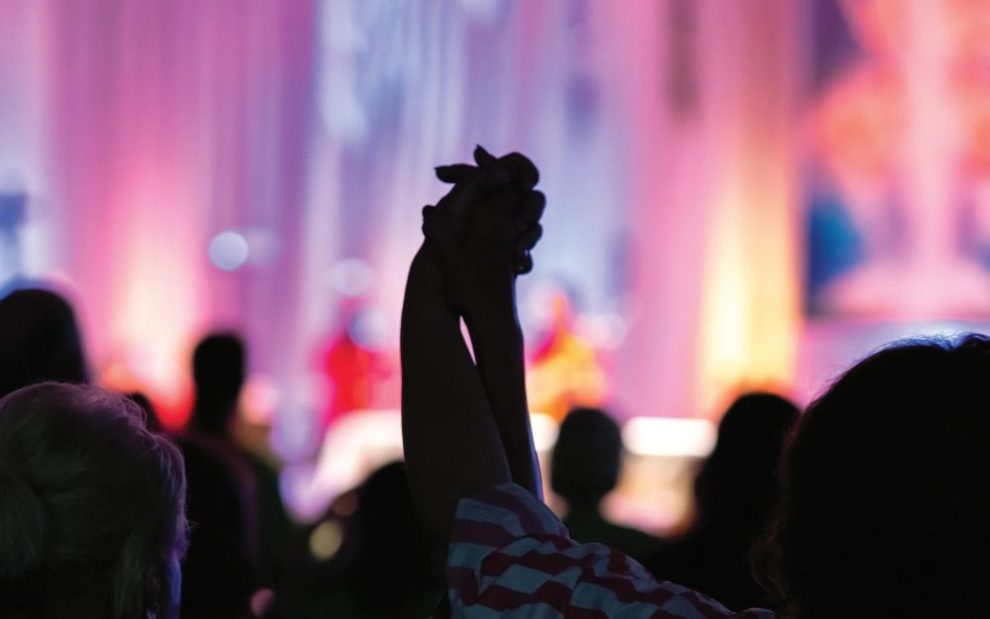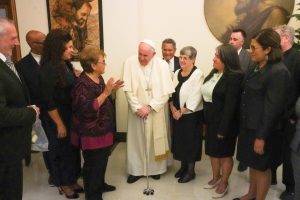Silvia Guevara remembers precisely why she joined Catholic Charismatic Renewal as a girl in San Alejo, El Salvador, during the 1970s.
“It wasn’t boring,” she says. “When you’re young, you like music, dancing.”
The way it was explained to her, she says, the joy of dancing and singing Christian hymns in Catholic charismatic parish meetings was akin to what she read in 2 Samuel 6, which describes King David and “all the house of Israel” dancing “before the Lord with all their might, with singing, and with lyres, harps, tambourines, sistrums, and cymbals.”
She now has been part of what she calls “la renovación” or “renewal” for 29 years, most of them at the Shrine of the Sacred Heart in Washington, D.C., the city to which she migrated as an adult. It was there she found a fledging group of Spanish-speaking charismatic members from her native country.
She was pulled in by the music, a big part of the twice-a-week meetings. The group often sings hymns or scripture-inspired songs set to Latin American cumbia rhythms. They also read Bible verses and sometimes break into spontaneous prayer. She has remained a charismatic Catholic for almost three decades now because of the sense of community, the joy in that particular form of expressive worship, and the warmth of its members, along with the commitment to organize to help others when help is needed, she says.
Seeds of renewal
The movement Guevara credits with fulfilling her spiritual life as a young person in El Salvador, and still today as an adult, actually started a few hours from her new home in Washington, says her former pastor, Capuchin Franciscan Father Moises Villalta, who currently lives in Puerto Rico. He says he began learning about the renewal while serving a growing group of charismatics at the predominantly Latino/a parish he served in Washington, D.C.
“From what I understand, it started at Duquesne [University] in Pittsburgh, when a group of young people from that university received this infusion, what they described as a renewal of baptism . . . and that’s what started the motor” of the charismatic movement, Villalta says.
Patti Gallagher Mansfield, who was a Duquesne University student when she took part in an event credited with giving rise to Catholic Charismatic Renewal, wrote an account for the university in 2015 describing a 1967 series of events involving two professors, several students, and others who took part in an interdenominational “charismatic home prayer” worship experience that year as they prepared for a retreat. Much of it focused on prayers seeking a “greater outpouring of the Holy Spirit.”
What followed, she said, was like nothing she had experienced before.
After the interdenominational prayer service, she went through a series of unexplained experiences while praying in front of the Blessed Sacrament in a chapel. After praying, she said she found herself in front of the Eucharist without recollection as to what had happened, “prostrate, flat on my face,” while “immersed in the love of God, a love that is totally undeserved, yet lavishly given.”
She left the chapel but returned with two other students without telling them what she had experienced. Other students followed them into the chapel.
Without explanation, some began “laughing, others crying, others (like me) felt a burning sensation coursing through them,” Mansfield wrote.
She said she later understood that those who had attended the interdenominational home prayer had received spiritual “gifts,” also referred to as “charisms,” and the happenings that followed in the chapel were a “baptism in the Spirit.”
Instead of keeping the experiences to themselves, the group decided to share what had happened with other students at university campuses like theirs.
Notre Dame University’s Holy Cross Father Ed O’Connor, in a story for Catholic Charismatic Renewal’s National Service Committee, wrote about how two of the professors who had participated in the Duquesne events visited the University of Notre Dame soon after their experience and “prayed over some of our students [at Notre Dame].”
“This was the beginning of the renewal at Notre Dame. From here, as well as from Ann Arbor, [Catholic Charismatic Renewal] spread across the country and around the world,” he wrote.
Far and wide
The experiences of people receiving a jolt of renewed faith reached Catholics in cities big and small outside the United States. The movement made a great impact in Latin America, including in Guevara’s small community of San Alejo in eastern El Salvador. It brought a different kind of worship style, Guevara says, that didn’t involve sitting in a pew quietly for an hour, where it was hard for a youth like her to make sense of who God was and represented.
“For a lot of Latino/a people, the fundamental problem has been not having a more personal encounter with God, particularly with Christ,” says Jesuit Father Allan Figueroa Deck, a theologian and scholar of Latino/a studies. “For a lot of them, [the renewal] did give them a more personal encounter. So that’s the first thing. And that explains why it was very successful in Latin America and continues to be, by the way. It had great success.”
Although the movement began in the United States with a “predominantly middle-class Euro-American [group] in the 1960s” it shifted inside the country “to a predominantly Hispanic membership from the mid-1980s,” wrote Carlos Alberto Steil and Ana Paula Pimentel Walker in a 2017 article, “Religious belonging in the Hispanic Catholic Charismatic Movement in San Diego.”
And when the United States began receiving immigrants such as Guevara who were fleeing civil conflicts and deteriorating economic conditions in Latin America during that time, with them came visiting preachers, including bishops, who tended to the Spanish speakers. Those who came into contact with the renewal carried rising enthusiasm for the U.S.-born movement into gatherings with expats, Deck says.
“They traveled around, and they liked to have big convocations where they would have music and praying and preaching and so forth,” Deck says. “It became the single, I would say, the most successful Catholic movement of Latino/a people that we’ve ever had.”
But their enthusiasm didn’t just stay in the United States. They took it home with them when they returned to their home parishes, where it quickly spread.
Some, such as St. Pope John Paul II, credited worldwide interest in the renewal as a “gift” of the Second Vatican Council. But it also would prove to be a gift that brought great comfort to waves of Catholic Latino/a migrants arriving in the United States, who found an instant community far from home in the renewal gatherings.
Sometimes parishes aren’t the most welcoming places for newcomers, Guevara says, and it’s easy to go in and out of Mass without anyone noticing new faces. But the renovación gatherings are intentional about integrating new members, as many of them know what it is like to leave home and find themselves alone in a new land.
“They made you feel welcome, gave you a hug,” Guevara says. “Who wouldn’t want that? That’s what people like. They shared. In the first seven years [in the United States], I never missed a day [of the gatherings].”
Gifts of the Spirit
Along with the singing and dancing, the gatherings, called asambleas, also offer contact with those who have the “gifts” or charisms of healing, as well as speaking in tongues, Guevara says. Those gifts found in the charismatic renewal come from another movement, which also began in the United States.
“From a theological point of view and a church history point of view, you can look at what has happened [with the renewal], really, as the development of Catholic Pentecostalism, because there’s no way to explain the charismatic renewal without talking about Pentecostalism,” Deck says.
Pentecostalism arose at the beginning of the 20th century in the United States, he says, with some people crediting it to the Azusa Street Revival, a series of religious meetings led by William J. Seymour in the early 1900s.
“Seymour, who was African American, began to practice a kind of Christianity that was somewhat evangelical, but it had a strong emphasis on the Holy Spirit and certain charisms, like speaking in tongues and the expectation of miracles. This was typical in Acts of the Apostles and in the early Christian church, where these types of activities existed, as did the possibility that in the church there exist gifts among some people for healing,” Deck says. “And so, the Pentecostals got into that, and then Catholic charismatics also got into that, because there’s nothing inherently against that in our faith.”
Renewal gatherings often invite special guests to preach and to spend time with the community in “healing services” to help members facing physical, mental, or other challenges, Guevara says. Sometimes members participate by placing hands on one another seeking help for whatever ails them. For those like Guevara, witnessing that healing has provided powerful personal experiences that involve not just the healing of the body or the resolution of a problem but also a healing of the soul, she says.
“We’ve been able to save many souls, and that’s what it’s about,” Guevara says.
Dangers of disunity
But what happens in the gatherings isn’t always understood or looked at in a positive light, including by other Catholics, says Villalta, who says he fielded complaints about “noise” from other parishioners who didn’t understand or like what the charismatic gatherings were about, calling them fanatical. In addition, their “expressive” way of praying rubbed some people the wrong way, including church leaders.
“There are some priests who don’t like this type of prayer,” he says. “I didn’t like it, but [the charismatics] were a big part of the parish; I knew I wasn’t going to exclude them but rather that we needed more openness.”
It wasn’t always easy to convince other Catholics, who felt they could only find God in silence, to be open to a different style of prayer.
Some of the misunderstandings come from the zeal or enthusiasm those new to the renewal sometimes find and take to other parts of a parish, where some of the more expressive forms of prayer interrupt the more contemplative styles, says Guevara.
For Guevara, while she enjoys taking part in the alabanzas, the songs that involve swaying and raising of hands and arms in prayer, she also likes praying in silence during the exposition of the Blessed Sacrament on Thursdays. Practices from the charismatic movement have their time and place, she says, but some charismatics transfer some of the worship styles to other spaces in the parish where they may not be appropriate. That’s when trouble begins.
She said she once saw one of her peers from the renovación bring alabanza music to holy hour, rankling the parishioners praying in silence before the Blessed Sacrament. But it’s important to educate new members, and it’s also important to educate those who are not charismatic on what the renewal is about, she says.
Pope Francis admitted in 2014 during a press conference on a flight returning to Rome from World Youth Day in Brazil, where the renewal has great popularity, that he didn’t always care much for members of the renewal.
“Back at the end of the 1970s and the beginning of the 1980s, I couldn’t stand them,” he said. “Once, speaking about them, I said: ‘These people confuse a liturgical celebration with samba school.’ I actually said that. Later I regretted saying it. I got to know them better. It is also true that the movement, with good leaders, has made great progress. Now I think that this movement does much good for the church, overall. In Buenos Aires, I met frequently with them, and once a year I celebrated a Mass with all of them in the Cathedral. I have supported them. I became a convert after I saw the good they were doing.”
And there’s a lot to learn from the good they do, says Villalta.
“They have a great sense of community, of unity,” he says, adding that they are quick to mobilize whenever the parish needs anything.
But it’s important to stress to members that the renewal is part of a parish and a bigger church and not a self-sufficient group that can function independently, Villalta says.
“That’s why it’s important to include them, find a cause for them inside parish life, because otherwise, you risk having a parallel church,” he says. “I realized from time to time that some of them had never been inside the church.”
For some, the asamblea, the gathering, had become a substitute for Mass, and that’s where some of the dangers arise, Villalta says, adding that in some cases lay leaders were dictating how the women should dress, introducing norms similar to evangelical churches, such as requiring long skirts.
While there have been issues of separation in other Christian churches where the charismatic gatherings have gained strength, “Catholic charismatics, by and large, have stayed connected and remain connected to the [local] bishop and the pastors of the church, with only occasionally a few issues where there’s disunity,” Deck says.
“Catholic charismatics usually try to demonstrate their Catholic commitment by being devoted to Mary,” he says. “They’ll say the Hail Mary or they’ll show traditional Catholic forms of piety that the Pentecostals wouldn’t do because they’ve been influenced more by the Protestant way of thinking.”
Charismatic Catholics in the United States received a moment in the spotlight with the 2020 confirmation of U.S. Supreme Court Justice Amy Coney Barrett, who is said to belong to the group People of Praise, which bills itself as a “charismatic Christian community” but about which little is publicly known.
Though some have speculated about People of Praise’s ties to conservative or right-wing political factions, the charismatic renewal gatherings Latino/a people in the United States attend have little to do with any political affiliation, says Villalta.
“They didn’t seem to be involved in that political polarization that exists in the [Anglo] church in the United States,” Villalta says. “They have other worries.”
As Deck sees it, the appeal of the renewal is more about how people experience faith in modern times, engaging their emotions and how they can lead toward a closer relationship with God that can then lead to a closer relationship with others.
It’s something that’s been missing from Catholicism in the United States, which has placed a lot of stress on rules and conformity, Deck says.
“We’re big on conformity to the rules, and Latin Americans are not into conformity,” he says. “They’re more into intuition, expressivity, and connecting faith with life, not just keeping to the textbook.”
And that’s what some Latino/a charismatic Catholics like Guevara say they are finding in movements like the renewal. She credits it with helping her be more devoted to the church, which she shows by attending Mass daily and listening to the voice of God in scripture, which in turn leads her to want to help anyone who may need her.
“It’s not just knowing the doctrines or knowing what the morality is,” Deck says. “We have to really desire to follow Christ by falling in love, in other words, being motivated by our total passions and not just by our intelligence.”
A gate to something new
Though it’s hard to pin down a precise number of charismatic Catholics in the world, the National Service Committee for the Catholic Charismatic Renewal says that the U.S.-born movement has spread to 238 countries and “touched over 100 million Catholics” worldwide.
Under Pope Francis, the renewal has received attention at the highest rungs of the church.
In 2019, charismatics received an important recognition as the Vatican instituted an ecclesial body called CHARIS, which serves as the international service organization for Catholic Charismatic Renewal communities worldwide.
“The pope wanted CHARIS to be established by the Holy See so that those in the Charismatic Renewal and the whole church would know that the Charismatic Renewal belongs fully to the universal church,” said Father Alexandre Awi Mello, secretary of the Dicastery for Laity, Family, and Life, in a 2018 interview with Vatican News.
Despite his confessed long-ago aversion to charismatics, Pope Francis has praised the movement’s members, saying in 2014 that the renewal’s “birth was willed by the Holy Spirit to be a current of grace in the church and for the church.”
And while some see it solely as a way to keep Catholics who prefer a more Pentecostal style of worship in the church, the pope pointed out that the renewal “serves” the church and may be a gate to something new.
“It renews us,” he said.
This article also appears in the February 2024 issue of U.S. Catholic (Vol. 89, No. 2, pages 10-15). Click here to subscribe to the magazine.
Image: Shutterstock/Jaroslav Moravcik














Add comment